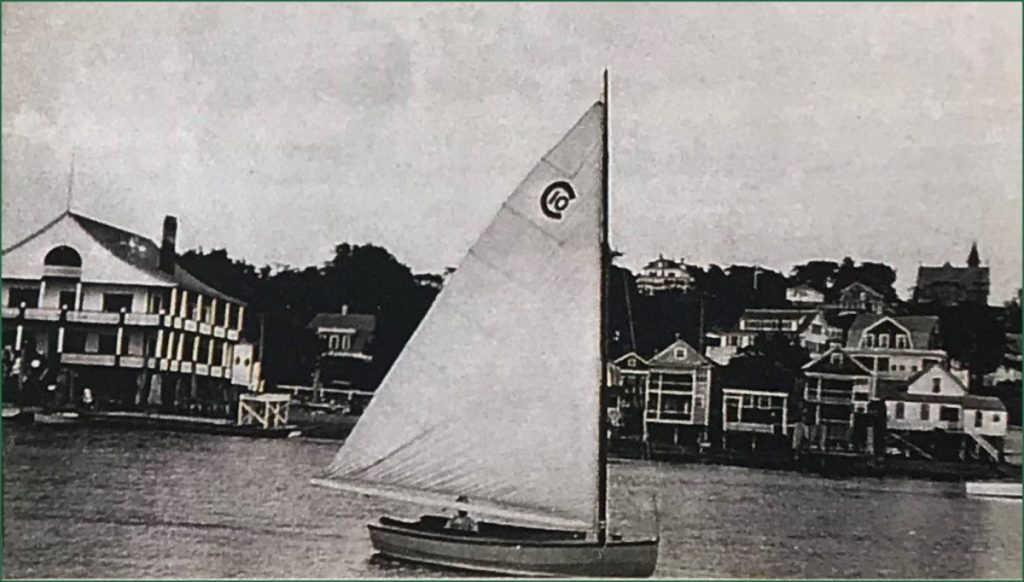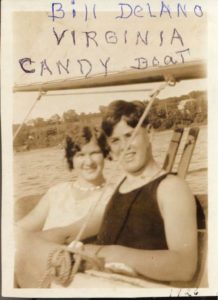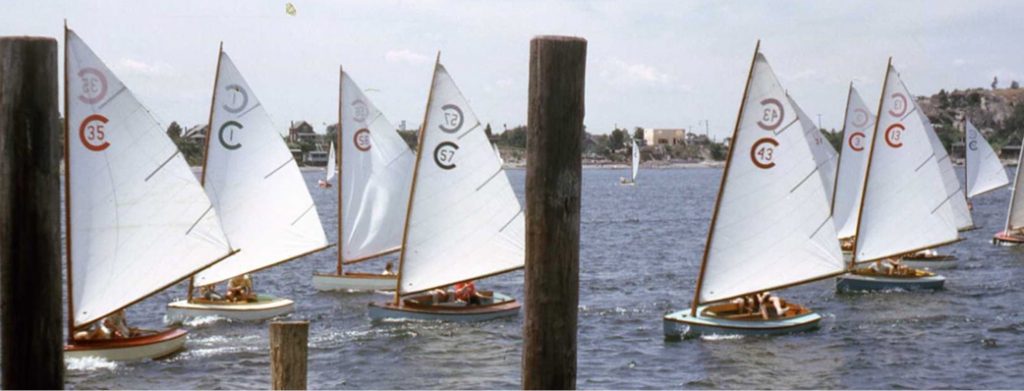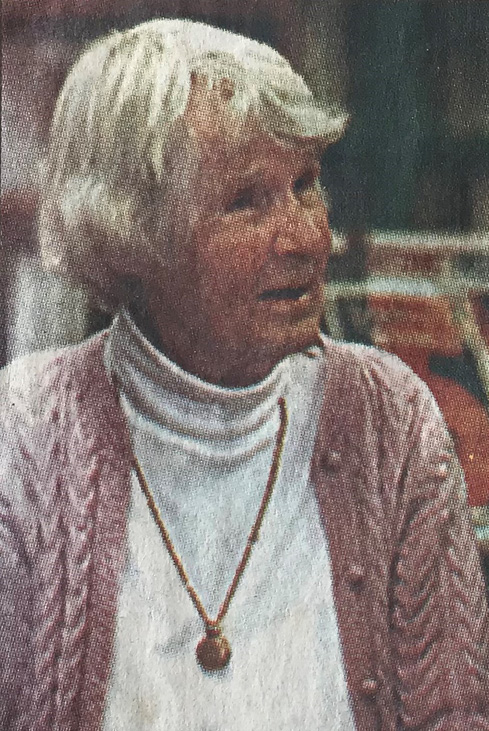By Gail M. Martin

Commander Clarence E. Wood (USN) sails Sugar Plum in front of the Fall River Yacht Club.
In the early 1920s, sailing and racing began in earnest for one-design classes. Among them was a small Marconi rigged catboat called the Candy class. The designer, T. Elton Wood, had children of his own, and his daughter Virginia was already an accomplished sailor at 14 years old. However, he envisioned other young people would also be attracted to this sport, so he designed a small, sturdy 13-foot boat with a hard chine bottom and heavy centerboard that would be easy to sail. It pointed well and could go upwind faster than a similarly sized Beetle class catboat. The Candy would cut through the waves and work to windward without capsizing.
T. Elton designed it in 1921, and by 1922 had built and sold the first seven to prominent members of the Fall River Yacht Club’s Tiverton Station in Tiverton, Rhode Island, and the Borden family from Touisset, Massachusetts. Wanting to appeal to youngsters, T. Elton chose to name it the Candy class and thus named each boat after a different candy of the era. Some owners decided to paint their boats in conjunction with this name – Licorice #8, for example, sported glossy black topsides for a number of years. He initially imagined an insignia of crossed lollipops on the sail but quickly realized that would be complicated and expensive to produce, so opted for the ‘C’ and a number instead. Right from the beginning they were alluring little boats enjoyed not only by youngsters, but adults as well.
Although T. Elton and his three brothers were all accomplished sailors, racers and boat designers, it was young Virginia who would become a key proponent of the class. Many of the first owners had purchased the boats for their children who did not yet know how to sail, let alone race. Consequently, Virginia was enlisted to accompany them as crew and instructor. In an interview with this author, she disclosed that she had never had a Candy of her own. T. Elton built Licorice #8 for himself, and his brother, Commander Clarence E. Wood, had built Sugar Plum #10 when he returned home from one of his Navy stints. Virginia was nevertheless happy to be a boat hopper. She coached both Mary Waring, the winner of the first Candy boat racing series, and later Ruth Kerns, who also became an accomplished competitor. She found herself competing against them in later Candy boat contests.
A key to the Candy class success was that the boats formed the basis of an informal arrangement where knowledgeable kids would teach others. In later years, families would buy Candies and a younger sibling would accompany an older brother or sister to learn sailing and racing skills. Those without younger siblings would recruit friends or extended family members. Families would keep Candies for years until each child would have their chance to race. Some families would buy two. Comfortable and easy to sail, people loved Candy boats.

Virginia Wood sails with Bob Delano, another Candy boat skipper, in 1926.
Virginia, named for a battleship thanks to her uncle’s influence, was also an accomplished swimmer and diver, and besides sailboat racing competed in these events through the 1920s. She won a number of races in the Candy class, and her photo was in the newspapers regularly with other female sailors and swimming competitors.
Nineteen twenty-two was the first full year of racing for the Candies. Fall River Yacht Club’s Tiverton Station had been operating since 1906 and sailing activity had waned. Officers were yearning for a revival of sailing and possibly a boost in membership. The large verandas of the club had been designed to provide members a view of sailing and water activities. These all provided added incentive for the emergence of the new class.
The first season was a busy one with seven boats
competing – Lollypop, Taffy, Tootsie Roll, Gumdrop, Peppermint, Butterscotch, and Lifesaver. The season was full of racing and provided a boost to activities at the club. The Candies raced every Saturday and one weeknight in the Tiverton Basin – three laps around a triangular course in full view of the yacht club. The Candies even sailed to Touisset for a couple of races as well as the Bristol Yacht Club.
For most of the season, the young new skippers of the seven Candies took older sailors along to help out. At one point mid-season, the older adults who were riding along became a source of contention. The yacht club race committee decided to limit the skippers and crews to people under 20. In turn, the yacht club provided a second race on Saturdays after the regularly scheduled race for the “old timers” to hop aboard a Candy and race against each other. In one race, all four Wood brothers were scheduled to compete.

Candy Class fleet (Lollypop #1, second on left) races in the Tiverton Basin in 1960s.
This ban on older folks only lasted for a few seasons as Candies were perfect for them to learn to sail and also fun to race, even for the experienced. And the Wood brothers (particularly T. Elton and Commander) liked sailing and racing them. Virginia described her home as one where her dad was always whittling wood and designing boats, and she was an assistant – holding lines while he drew. And their home (built and lived in by both brothers) had regular lively dinner-table conversations with T. Elton and Commander rehashing their latest race with Virginia chiming in some of the time.
The popularity of the Candies grew, with twenty boats built by 1930. They were regular participants in the Narragansett Bay Yacht Racing Association regattas. They would mostly be sailed to the regattas and left anchored overnight. On Sunday they would be sailed or towed home.
Virginia married Victor McKay in 1929 and moved from Tiverton, but came back regularly to visit her parents and spend summers sailing and racing Candy boats with her daughters. She was aways welcome at the Wood family home on Prospect Hill.
Although the Fall River Yacht Club’s Tiverton Station was destroyed in the hurricane of 1938, most of the Candies survived and the fleet continued sailing. More Candies were built and the fleet numbered around fifty-seven by the end of the 1950s. A group of old members of the Fall River Yacht Club rented quarters in the Standish Boatyard, also located in the Tiverton Basin, and held events and meetings there. The Tiverton Yacht Club was incorporated in 1945. The docks and floats in front of Standishes became the new hub of Candy class activity and racing resumed there.
In 1959, Virginia moved back to Tiverton and became the Tiverton Yacht Club’s official sailing instructor in the TYC-owned Sugar Daddy #15. She was the unofficial ‘ambassador’ for the Candy class as she continued to teach sailing and promote the class. One of her former sailing students, Michael Duggan, whose family owned three Candy boats over the years, took lessons from her in the mid-1960s with a few of his close friends and wrote in the book Candy Boat Memories that it was the best summer of his life, chiefly because of the sailing lessons and introduction to racing. While his niece was teaching sailing and developing more Candy boat skippers, in 1962 the Commander and Sugar Plum were still listed in the Tiverton Yacht Club logbook, and he became known as the oldest Candy boat skipper in the fleet.

Virginia adds to the Candy Boat Memories forum in the 1990s.
In the 1990s, the Tiverton Library commissioned a project to collect oral histories of Candy boat skippers and enthusiasts. Forums were held for people to come and discuss their Candy boat experiences. Others were invited to submit written memories if they could not attend the meetings. It culminated in the publication of Candy Boat Memories. Virginia was present at each meeting and offered her experiences to the group. She had only one lament. She wondered if she should have exhibited a Candy at the boat shows during the heyday of Candy boat sailing to promote them outside the local area. (Actually, someone had taken Dolly Dimple #43 to a boat show in the mid-‘50s, before Virginia took residence again in Tiverton.)
In the late 1960s, an entrepreneur had received permission to manufacture fiberglass Candies and several were built, but that only mildly pre-dated the development of the 420 class which shortly overtook Candies in popularity, with 420 racing starting at TYC in 1970. In the early 2000s, though, Virginia with her daughters decided to get the family-owned Sugar Plum refurbished so it would sail again, and they did. One of the biggest fans of the Candy class as well as one of its most accomplished teachers and skippers, Virginia lived to 99 years old, never forgetting how sweet the ride or race in a Candy boat. ■
The Candy class has been chosen to be displayed in the new Wells Hall at Mystic Seaport Museum, featuring Lollypop #1. Thanks to the Wood and Parks families for the photos of Virginia and her daughters, and her granddaughter, Karen Chaudierre, for her assistance.
Gail M. Martin is a Candy boat historian who lives in Jamestown, RI. To find out more about her books please go to newenglandmaritimepublications.weebly.com.



